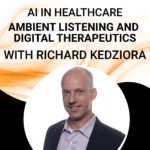The tech world loves the mantra “move fast and break things,” but in healthcare, the thing you break could be a person. So, how do you drive innovation when the stakes are life and death? This episode features RJ Kedziora, co-founder of Estenda, who shares invaluable lessons from the front lines of digital health.
Key Takeaways
- AI-powered tools like ambient listening scribes are revolutionizing clinical workflows by significantly reducing “pajama time”—the after-hours administrative burden—freeing up clinicians to dedicate more valuable minutes to direct patient interaction and care.
- Ethically harnessing AI means focusing on augmenting human capabilities and expanding access to care, while proactively managing risks such as inherent bias and ensuring that technology complements, rather than replaces, vital human connection and trust.
- Shifting focus from traditional time management to actively managing personal energy—as outlined in concepts like “Productive Harmony”—can unlock higher productivity and help leadership and their teams sidestep burnout, fostering a more sustainable approach to achieving strategic goals in Digital Transformation.
The Genesis of Productive Harmony: Beyond Time Management
Many high-achievers grapple with balancing demanding careers and personal pursuits. RJ Kedziora, a seasoned digital health entrepreneur and aspiring author, found himself exploring this very challenge, leading to his upcoming book, “The Productive Harmony Framework.” This endeavor wasn’t just about adding another accomplishment to his list, which already includes accolades like the HIMSS Davies and Health 2.0 Leadership awards. Instead, it stemmed from a deep-seated passion to understand the core of productivity.
Initially, like many, RJ’s thoughts gravitated towards traditional time management. However, he quickly realized a fundamental truth: time itself is finite and uncontrollable. We all get 24 hours. What we can control, he argues, is our energy. As RJ puts it:
You can’t control time. And so what can you control? You can control yourself, your energy.
This shift in perspective forms the cornerstone of his framework – focusing on how to channel personal energy effectively to maximize the time we do have. Even sleep, often seen as passive, becomes a productive activity in this model, as it’s crucial for replenishing the energy needed for daily tasks and crucial for overall Digital Transformation efforts within organizations.
The journey of writing the book itself became a lesson in energy management. The initial thought of generating 50,000 words of entirely original content was daunting. However, RJ learned that a compelling book, much like effective AI development, involves more than just solitary creation. It’s about weaving together personal narratives, thorough research, and insights from experts. He connected with PhDs specializing in time management, transforming the writing process into a research project—a familiar territory for someone immersed in the data-driven world of digital health. This approach underscores a key principle for leaders: complex projects are often more manageable when broken down and approached with a research-oriented mindset, integrating diverse sources of information rather than relying on a single stream of thought.
Unearthing the Roots of Productivity: From Taylorism to Energy
Delving into the history of productivity, RJ uncovered fascinating insights. The concept of managing time isn’t new; even early humans had to consider time for survival. However, the modern theory of time management largely began in the early 1900s with Frederick Taylor, whose methods, now known as Taylorism, involved breaking down tasks and using stopwatches to optimize efficiency. This was an early attempt at Business Process Management (BPM), focusing purely on time.
What’s often overlooked, RJ’s research revealed, is that Taylor’s rigorous time-focused approach didn’t lead to sustained productivity increases. Instead, it resulted in burnout, and Taylor was eventually dismissed. This historical lesson is incredibly relevant today. In an era obsessed with constant output and efficiency, particularly in risk-averse environments like healthcare, the relentless focus on “doing more in less time” can be counterproductive. RJ posits that energy management, not just time management, is the more effective strategy for navigating the demands of the 21st century and fostering sustainable employee engagement.
Energy Management in Practice: A Day in the Life
So, what does managing energy look like practically? For RJ, it starts with an early morning triathlon training session. Counterintuitively, this intense physical activity doesn’t deplete him; it energizes him for the day, reducing his reliance on caffeine. This physical exertion builds mental fortitude, crucial for tackling complex challenges in Digital Transformation.
His daily structure is a testament to understanding his personal energy flows. Mornings are reserved for tasks requiring deep focus and critical thinking. Midday is for administrative activities that, while necessary, demand less intense concentration. The late afternoon often brings a burst of creativity, which he channels into marketing activities or working on his book. This conscious alignment of tasks with natural energy peaks and troughs is a powerful strategy for anyone in a leadership role aiming to optimize their team’s output without causing burnout.
A significant drain on energy is context switching. Rapidly shifting between unrelated tasks is incredibly costly from an energy perspective and can lead to burnout. Another modern culprit is the smartphone. Even with notifications off, its mere presence can be a distraction. RJ found a simple yet powerful solution:
And what’s fascinating, by putting the phone in another room, made a significant difference of not having it front of mind and not distracting me.
This simple tactic can enhance productivity and is a small step towards creating an environment where Human-Centered AI principles, which value focus and well-being, can thrive.
AI: A Partner in Productivity and Energy Conservation
The conversation around energy management naturally leads to the role of technology, specifically Artificial Intelligence (AI). RJ dedicates a chapter in his book to AI’s potential for enhancing productivity. He sees Generative AI, in particular, as a significant boon for society, helping individuals and organizations become more efficient. This isn’t about replacing human effort entirely, but about augmenting it, allowing us to conserve our precious cognitive energy.
Consider the task of preparing for user interviews—a common activity in product development and understanding patient needs in healthcare. RJ shared an example where he needed to interview PhD experts in smell testing, a new domain for him. Traditionally, planning these interviews, crafting relevant questions, and ensuring a logical flow would take several hours. Using a Generative AI system, he could provide context and objectives, and the AI would generate dozens of potential questions in minutes. While he still curates and refines these (the AI provides an “80% solution”), the time and mental energy saved are immense. This Human-AI Collaboration allows professionals to focus on higher-value activities like critical analysis and strategic thinking, rather than getting bogged down in preliminary legwork.
This concept of an AI “thinking buddy” or research assistant can democratize the brainstorming process. While human collaboration is invaluable for critical projects, AI offers an accessible way to process information and generate initial ideas for a wider range of tasks, truly aiding in the Digital Transformation of everyday work.

AI in Action: Transforming Healthcare Today
The application of AI extends profoundly into RJ Kedziora’s specialty: digital health. It’s important to distinguish between different types of AI. Machine Learning (ML), often considered the “forgotten AI,” has been making a significant impact for some time, particularly in medical image analysis. Algorithms analyze images from X-rays, MRIs, or retinal scans (like in diabetic retinopathy detection – a leading cause of preventable blindness) with remarkable accuracy. These ML systems can often outperform human practitioners in specific, repetitive tasks and, crucially, they don’t experience fatigue. The FDA has approved nearly 900 such Machine Learning systems over the past decade, with the vast majority focused on imagery. This is a clear win for patient outcomes and diagnostic efficiency, demonstrating AI’s power in augmenting human capabilities within risk-averse environments.
More recently, Generative AI has entered the healthcare arena, with “ambient listening” being one of its most rapidly adopted applications. This technology addresses a major pain point for clinicians: the dreaded “pajama time,” or hours spent after work completing patient notes and charts. RJ’s own daughter, a physical therapist, faces this daily, needing to document notes for numerous patients after her official workday ends. Ambient listening allows an AI system to passively capture the conversation between a doctor and patient during an encounter and then automatically generate clinical notes. RJ highlights the human benefit of this technology:
And what I like about that approach is it lets the doctor, the medical practitioners get back to why they got into medicine.
This application of Human-Centered AI allows medical professionals to reclaim their time and focus on what truly matters: direct patient interaction and care, rather than administrative burdens. It fosters better employee engagement by reducing burnout and allows doctors to engage more meaningfully with patients, improving the quality of care and strengthening trust.
Beyond note-taking, this technology can also streamline medical coding for billing, further improving administrative efficiency. The primary impact of AI in healthcare currently revolves around these backend efficiencies, freeing up human resources for more critical, patient-facing tasks. This is a core aspect of successful Digital Transformation in the sector.
The Rise of Digital Therapeutics: Software as Medicine
Another fascinating area of innovation is Digital Therapeutics (DTx). RJ explains these as a special class of digital health applications that are distinct from the plethora of general wellness apps. While a general health app might be akin to an over-the-counter vitamin, a digital therapeutic operates on a different level. RJ clarifies:
A digital therapeutic takes that to the next level. It’s a comparison to an actual drug or medication that went through extensive clinical trials and clinical regulatory approval.
Once approved by bodies like the FDA in the US, a DTx can be prescribed by a doctor to treat, manage, or prevent a specific medical condition. This is a significant step in the evolution of Automation and personalized medicine.
Mental health is a prominent field for DTx, given the global shortage of professionals. Recently, new DTx systems for managing migraines have also been developed. A key advantage is that digital interventions often avoid the significant side effects associated with many pharmaceutical drugs. Instead of ingesting a chemical, patients engage with software designed to achieve a specific therapeutic outcome. This represents a paradigm shift towards more Human-Centered AI approaches to treatment.
However, reimbursement presents a challenge, particularly in the US. While a DTx might gain FDA approval, getting insurance companies to cover it has been a hurdle. RJ notes that the EU has adopted a more integrated approach, linking regulatory approval with reimbursement pathways, a model that could foster faster adoption and build greater trust in these novel treatments. Recent changes in the US are beginning to address this, aiming to make these innovative therapies more accessible.
AI-Powered Patient Engagement and Follow-Up
Generative AI is also paving the way for new forms of patient engagement, such as automated checkups. Imagine an AI system that follows up with patients at home, ensuring they are adhering to prescribed medication schedules or monitoring for potential complications. This can augment the work of nurses, who have limitations on how many patients they can personally contact daily. Such Human-AI Collaboration can significantly enhance patient adherence and provide early warnings for adverse events, especially for patients managing chronic conditions in an outpatient setting.
This capability takes patient support to a new level, moving beyond simple reminders to encouraging specific behaviors that lead to better health outcomes. While the thought of an AI handling aspects of care traditionally managed by humans raises questions, the potential for scalable, consistent follow-up is immense. These systems need to be developed with a Human-Centered AI approach, ensuring they are supportive and not intrusive. The goal is to ensure that patients feel cared for and that their journey through treatment is effectively supported by this blend of human and artificial intelligence. This can enhance trust between patients and healthcare systems by providing more continuous support.
Navigating the Ethical Landscape of AI in Healthcare
The rapid advancement of AI in healthcare inevitably brings a host of ethical considerations to the forefront. Fear, uncertainty, and doubt (FUD) are common reactions, and it’s crucial for leadership in Digital Transformation to address these proactively. Key questions revolve around how these systems will be used, the potential risks to patient care and wellness, and ensuring equitable access.
RJ emphasizes a crucial perspective on AI’s role:
AI generally stands for artificial intelligence, but you mentioned it a minute ago, I really think of it as augmented intelligence.
The goal is to enhance existing systems and processes, making them better than they are today. While the idea of an AI calling a family member instead of a nurse might feel impersonal, the reality is that AI can offer a level of empathetic interaction that might surprise us. Studies have shown that AI-generated communications can sometimes be perceived as more empathetic than those from hurried human professionals. This isn’t a failing of humans, but a reflection of the immense pressures and energy constraints they face. The AI, free from fatigue, can maintain a consistent level of empathetic engagement. Therefore, the aim should be a blended approach – a Human-AI Collaboration where technology handles routine check-ins or data gathering, freeing up human caregivers for more complex and nuanced interactions.
Concerns about performance monitoring, as highlighted by scholars like Fei-Fei Li regarding ambient listening, are valid and need to be managed through transparent governance and a focus on using AI to support, not surveil, staff. Bias in AI is another critical issue, stemming from the human-generated data it learns from. However, RJ points out that it can be easier to identify and mitigate bias in an AI system than in individual humans, who may be unaware of their own inherent biases. AI systems can also be valuable “second opinion” tools, aware of vast amounts of research that no single human could process, helping to reduce errors and improve diagnostic accuracy. Ultimately, in risk-averse environments like healthcare, it may become irresponsible *not* to use these tools, provided they are implemented ethically and with robust safeguards to build and maintain trust.
The Horizon: AI’s Future in Healthcare
Looking ahead, RJ Kedziora is optimistic about the transformative potential of AI in healthcare. He often refers to a well-known insight on technological progress:
My favorite quote these days is from Bill Gates that we as humans tend to overestimate what’s possible in two years and underestimate what’s possible in 10.
The true capabilities of these technologies in a decade are likely beyond our current imagination. While there’s fear of job displacement, RJ believes the focus will remain on augmentation—the indispensable human touch will still be paramount, even as AI systems demonstrate increasing empathy.
The overarching trajectory is positive: AI is set to make a profound difference in global health and wellness. Challenges around technical equity and access must be addressed to ensure these benefits reach everyone. However, the ongoing Digital Transformation powered by AI and Machine Learning promises a future where healthcare is more efficient, personalized, and ultimately, more human, thanks to intelligent automation and enhanced Human-AI Collaboration.
Conclusion: Embracing Energy, Ethics, and AI in Healthcare’s Next Chapter
This exploration with RJ Kedziora illuminates a path forward where managing our energy, not just our time, becomes paramount for driving innovation. As healthcare undergoes its profound Digital Transformation, technologies like AI-powered ambient listening and Digital Therapeutics offer immense potential to enhance efficiency and patient care. However, this journey must be navigated with a steadfast commitment to Human-Centered AI, ensuring that these advancements augment our capabilities, foster trust, and uphold the highest ethical standards, ultimately allowing healthcare professionals to focus on the human connection at the heart of medicine.
Discover a Blueprint for Real-World Impact
Ready to see how these principles of innovation and Human-Centered AI are being put into practice? To explore the pioneering projects and case studies that turn the promise of AI in healthcare into tangible solutions that improve lives, visit Estenda.com to learn more about their work on the front lines of digital health.
Join the Conversation
RJ Kedziora shared how AI can give time back to healthcare professionals and improve patient engagement. What’s one way you see AI reshaping a critical process within your industry, and what’s a key ethical consideration your team is discussing? Share your insights and join the dialogue with other leaders on the Innovation Tales LinkedIn page.
Recommended Resources
- Stay tuned for sneak peeks from RJ Kedziora on his upcoming book, “The Productive Harmony Framework.” Join his newsletter: Productive Harmony Updates
- Book recommendation from the episode: “When: The Scientific Secrets of Perfect Timing” by Daniel H. Pink. Explore it on Goodreads.

Episode timeline
- 00:00 Introduction: The Moral Calculus of AI in Healthcare
- 00:00 Meet RJ Kedziora: Balancing Speed and Safety in Digital Health
- 00:00 The Productive Harmony Framework: A Journey from Triathlons to Time Management
- 00:00 Energy Management: Maximizing Productivity and Avoiding Burnout
- 00:00 AI in Digital Health: From Machine Learning to Ambient Listening
- 00:00 Digital Therapeutics: The Next Frontier in Healthcare
- 00:00 Ethical Considerations: Balancing AI and Human Touch in Healthcare
- 00:00 Future of Healthcare: AI's Transformative Potential
- 00:00 Conclusion: Key Takeaways and Future Episodes





